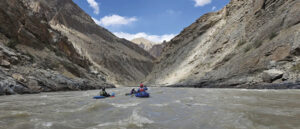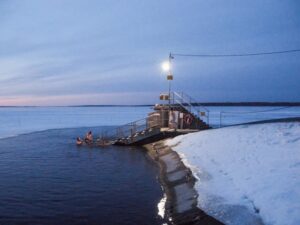While lighthouse keeping has become an all-but-extinct job, many of these unmanned structures continue to keep mariners safe. In so doing, they withstand daily pounding from the waves in some of the most remote corners on Earth.
Stannard Rock Lighthouse
Lake Superior is the world’s largest freshwater lake by surface area. Much of its shoreline, on both sides of the U.S.-Canada border, is lonely and uninhabited. The stormy lake has over 500 shipwrecks. The best known occurred as recently as 1975, when the Edmund Fitzgerald went down in a storm, killing all 29 aboard. Canadian folk singer Gordon Lightfoot wrote a famous song about that shipwreck. Suffice it to say, ships needed all the help they could get on that treacherous lake.
On a lone reef 39km from land, in 33m of choppy water, is the Stannard Rock Lighthouse. Locally, it is called “Stranded Rock” or “stag station.” It is one of 78 lighthouses on Lake Superior.
Named after Captain Charles Stannard, who discovered this reef in 1835, construction took a long five years (1878-1883). Crazy weather and troublesome ice caused several delays. But a lighthouse near that reef was necessary because of the increase in shipping.

Stannard Rock Lighthouse. Photo: USCG
The lighthouse contains thousands of tons of concrete and sandstone, as well as brick and iron. The tower itself has seven levels, including living quarters for the keepers. It also had a library, a kitchen, and a lens for the light.
Although it was fully equipped, life in the lighthouse was certainly a hardship post. The wave-battered base needed frequent reinforcement with more steel and concrete. During winter, ice built up on the platform regularly, forcing the keepers to hack away at it with pick axes. The inhospitable and unpredictable weather often made it unsafe to occupy, so the keepers were often away from the lighthouse. It is automated now.
Currently, the lighthouse often serves as a base for scientific research on Lake Superior.
Thridrangar Lighthouse
On the south coast of Iceland, the “three rock pillars” or “three fingers” erupt from the blue-black waters. These basalt columns are exceptionally dangerous to climb, and worse to live upon. That did not stop intrepid Icelanders from building and manning one of the world’s most dangerous lighthouses.
It lies seven kilometers off Iceland’s southwest coast. A single-story white lighthouse with a red roof sits atop the tallest of the pillars, the 36m-high Stóridrangur. The building is only 7.4m high.

Thridrangar Lighthouse in Iceland. Photo: Facebook
Construction of this little house was no easy task. Mountaineers from the nearby Westman Islands had to bolt a chain ladder to the pillar to ferry materials up. Construction took a month of painstaking hauling.
In later years, officials installed a helipad to make life easier. The lighthouse is now only accessible via helicopter rather than by boats in those rough seas.
Klein Curaçao Lighthouse
Ten kilometers off the south coast of the island of Curaçao, an uninhabited little islet called Klein Curaçao offers white sand beaches and turquoise water. A typical Caribbean paradise, right? Think again. The land suffered many hardships over the centuries.

Klein Curaçao lighthouse. Photo: Fokke Baarssen/Shutterstock
Due to its isolation, this 1.7 square kilometer island in the Dutch Caribbean once served as a quarantine stop for enslaved Africans before they were shipped to the mainland. Later, phosphate mining made the soil arid and more saline. Goats were also allowed to roam freely, which furthered Klein Curaçao’s desertification.
A little back from shore lies a remnant of its past: a desolate pink lighthouse. It seems out of place amid the desert ground cover. The original lighthouse dates back to 1850 but was destroyed by successive hurricanes. This is the rebuilt structure. The many shipwrecks in the area, including several on the island itself, made the lighthouse vital.
The former keepers lived modestly in the 22m-high, two-story tower. There was no running water or electricity. Fresh water had to be brought from the mainland. The place is abandoned now, but the lighthouse continues to operate on an LED beacon powered by solar.
You can explore the island and its lighthouse freely.
Bishop Rock Lighthouse
Although the Guinness Book of World Records dubiously lists Bishop Rock as the world’s smallest island, it is really just a rock. This platform in the vast North Atlantic unexpectedly became home to one of England’s tallest lighthouses.
You will find Bishop Rock in the western reaches of the Isles of Scilly, just off the coast of Cornwall. Several shipwrecks, including a famous disaster in 1707 that cost the lives of over 2,000 sailors, prompted reluctant authorities to finally give in to pleas for a lighthouse. The Isles of Scilly carry the unfortunate legacy of over 900 shipwrecks.
Authorities started with an iron contraption with a beacon in 1847, but the waves washed it away. In 1851, builders got to work on a sturdier structure. It took seven years to build due to constant interruptions from storms and tides. The tower stands 49m tall and has 10 floors equipped with living quarters, oil rooms, and a helipad. The keepers also used neighboring islands as bases for themselves and their families.

Bishop Rock Lighthouse. Photo: Stephen Rees/Shutterstock
The lighthouse on this tiny rock had several drawbacks. Waves smashed against it and broke off pieces of stone from its base. Frequent gales rocked the tower. The lighthouse needed extra reinforcement from iron bolts and an entirely new cylindrical base to deter the waves. Some storms were so bad that waves and wind broke windows and damaged equipment inside.
In 1992, authorities completely automated the popular landmark.
Anita Lighthouse
At the very tip of Russia’s Far East, on Sakhalin Island, a small stretch of sea separates Russia from its old rival Japan. Here stands the Aniva Lighthouse. This poor structure sits at the crossroads of two political spheres.

Aniva Lighthouse in Russia. Photo: idquadro/Shutterstock
The Japanese built the lighthouse, which they called Nakashiretoko, during World War II when they occupied part of Sakhalin. It stands 31m tall with nine floors. It’s now non-functional and empty except for rusting and broken objects from earlier times. During its day, however, its light was visible up to 35km away and guided ships caught in the thick fog common to that region.
The Soviets took over the island during the last days of the war and manned the lighthouse until the 1990s. In 2006, personnel completely abandoned it. Now forgotten by both Russians and Japanese, it has become a sort of tourist destination, accessible by boat from the village of Novikovo.






